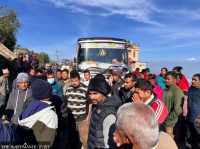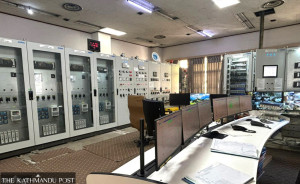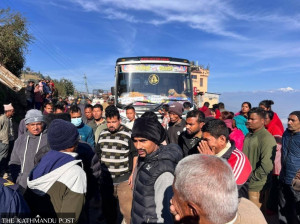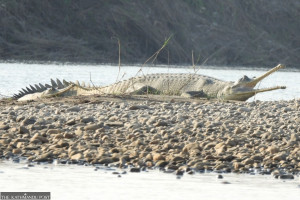Bagmati Province
On other side of Trishuli, track being opened for way parallel to Narayanghat-Muglin road
Project seen as a crucial step in improving the reliability of Nepal’s key transport corridor.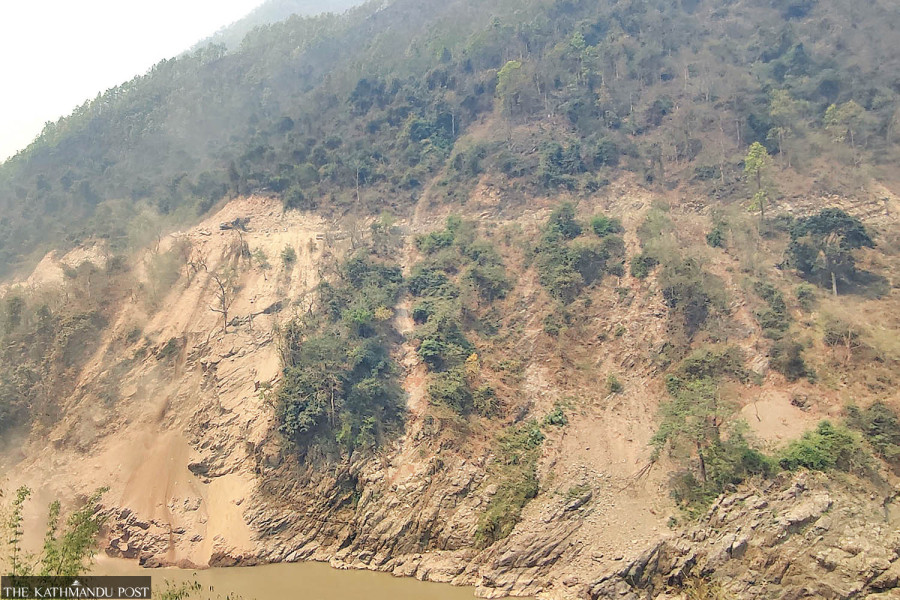
Ramesh Kumar Paudel
Travellers passing through Muglin of late may have noticed heavy-duty machines digging into the cliffs across the Trishuli river, with stones and soil falling directly into the water—a concern for locals and environmentalists alike.
This is part of a road work—an alternative to the Narayanghat-Muglin road section.
Construction has started on an alternative road running parallel to the Narayanghat-Muglin stretch, one of the country’s busiest and most landslide-prone routes. Despite being widened to two lanes by Asian standards, the Narayanghat–Muglin road often suffers landslides, mostly during the monsoon, disrupting transport linking Kathmandu and Pokhara with the country’s eastern and western parts.
As a plan to tackle the decades-old problem, the project to build a parallel route on the opposite side of the river has been dusted off and is being implemented.
The Division Road Office in Damauli, the district headquarters of Tanahun, has signed an agreement with a contractor to kick off the initial phase. According to Engineer Rajendra Karki, the goal for the current fiscal year of 2024-25 that ends in mid-July is to open a four-kilometre track. The total length of the new road is expected to be around 24 kilometres.
The alternative route begins from the southern side of the hills in ward 4 of Aanbu Khaireni Rural Municipality, Tanahun, passing through Gaighat, Dasdhunga and Thimura before connecting to Gaindakot of Nawalparasi East.
“Though only limited work is being done this year, the route is intended to serve as an alternative road and will be 11 metres wide—matching the width of the existing Narayanghat-Muglin road, where the terrain allows,” said Karki.
The current contract, signed on February 6, involves widening an existing track opened earlier by Aanbu Khaireni Rural Municipality, along with constructing retaining walls.
As per the agreement, the project of constructing four-kilometre stretch must be completed by early mid-July, with a budget of Rs26.9 million. However, the contract was awarded for Rs12.6 million, indicating a significant cost reduction by the contractor.
Milan Bhujel, ward chairman of Aanbu Khaireni-4, expressed satisfaction at the securing of federal funding for a project that aligns with local priorities. However, she also raised concerns about the environmental impact of dumping construction debris directly into the Trishuli river. “Excavated stones and soil must be managed properly,” she said.
Engineer Karki, who visited the site recently, acknowledged the issue. He said the contractor had been instructed not to dump materials into the river, and to store them elsewhere. “There may be some steep areas where disposal is difficult, but otherwise, debris should not be thrown into the river,” he said.
Though still in its early stages, the parallel road project is seen as a crucial step in improving the resilience and reliability of Nepal’s key transport corridor, particularly during the monsoon season.
In a bid to upgrade the 33.2km road to Asian Highway standard, the Narayanghat-Muglin road was expanded to a width of 9 to 11 metres from 5 to 5.5 metres. The widening work was completed in 2018 against the initial deadline of 2015.
The Narayanghat-Muglin Road Widening Project, supported by the World Bank, also aimed to address road safety and facilitate express movement of vehicles and environmental sustainability issues along the trade corridor.
However, the road section witnesses recurring landslides hindering vehicular movement for hours, as well as posing a threat to the general public with the falling debris.
In July last year, two buses carrying 65 passengers along the Narayanghat-Muglin road were hit by a landslide in the wee hours and swept away by the Trishuli river.
The success of this initiative of building an alternative road parallel to the Narayanghat-Muglin road could serve as a model for addressing similar challenges in the country’s other vulnerable regions, where most of the roads in hills and mountains are carved out in difficult terrains.




 8.12°C Kathmandu
8.12°C Kathmandu1.jpg)


